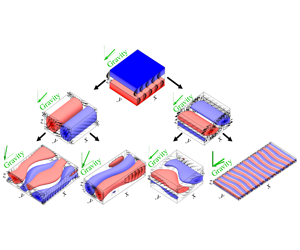Article contents
Invariant states in inclined layer convection. Part 2. Bifurcations and connections between branches of invariant states
Published online by Cambridge University Press: 09 July 2020
Abstract

Convection in a layer inclined against gravity is a thermally driven non-equilibrium system, in which both buoyancy and shear forces drive spatio-temporally complex flows. As a function of the strength of thermal driving and the angle of inclination, a multitude of convection patterns is observed in experiments and numerical simulations. Several observed patterns have been linked to exact invariant states of the fully nonlinear three-dimensional Oberbeck–Boussinesq equations. These exact equilibria, travelling waves and periodic orbits reside in state space and, depending on their stability properties, are transiently visited by the dynamics or act as attractors. To explain the dependence of observed convection patterns on control parameters, we study the parameter dependence of the state space structure. Specifically, we identify the bifurcations that modify the existence, stability and connectivity of invariant states. We numerically continue exact invariant states underlying spatially periodic convection patterns at  $Pr=1.07$ under changing control parameters for a temperature difference between the walls and inclination angle. The resulting state branches cover various inclinations from horizontal layer convection to vertical layer convection and beyond. The collection of all computed branches represents an extensive bifurcation network connecting 16 different invariant states across control parameter values. Individual bifurcation structures are discussed in detail and related to the observed complex dynamics of individual convection patterns. Together, the bifurcations and associated state branches indicate at what control parameter values which invariant states coexist. This provides a nonlinear framework to explain the multitude of complex flow dynamics arising in inclined layer convection.
$Pr=1.07$ under changing control parameters for a temperature difference between the walls and inclination angle. The resulting state branches cover various inclinations from horizontal layer convection to vertical layer convection and beyond. The collection of all computed branches represents an extensive bifurcation network connecting 16 different invariant states across control parameter values. Individual bifurcation structures are discussed in detail and related to the observed complex dynamics of individual convection patterns. Together, the bifurcations and associated state branches indicate at what control parameter values which invariant states coexist. This provides a nonlinear framework to explain the multitude of complex flow dynamics arising in inclined layer convection.
- Type
- JFM Papers
- Information
- Copyright
- © The Author(s), 2020. Published by Cambridge University Press
References
- 10
- Cited by


